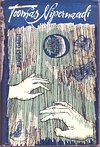

Auf ein Miniaturbild klicken, um zu Google Books zu gelangen.
|
Lädt ... Toomas Nipernaadi : romaan novellidesvon August Gailit
 Keine Keine aktuelle Diskussion zu diesem Buch.  I selected this from the Dedalus catalogue because I like stories of wanderers and liked the cover image too. It's set in rural Estonia with an emphasis on the changing seasons as Toomas roves from village to village, inserting himself into local dramas and trying to solve practical problems, but always with an amorous eye for the womenfolk. He spins unlikely stories, sometimes seeming to see through the behaviour of others while at other times being as nonplussed as any. Just when you think he's a chancer he also expresses his most sincere feelings. The book was written in 1928 but the translation has a very contemporary feel. It mixes American and English slang and can occasionally seem jarring when describing old ways but generally works for the timeless folk elements. The environment is described in original and lyrical language. It's a book for those who enjoy folk-based storytelling. “Toomas Nipernaadi” (1928) is a classic of Estonian literature and is the best known work of author August Gailit (1891-1960). The title character is quite an iconic fictional figure and has been immortalized in everything from travel agency names to alcoholic drinks. A 1983 film based on the book is also quite popular. His very name is now a synonym for wanderlust in the Estonian language. Nipernaadi is a vagabond minstrel character who wanders around the countryside paying court to various rural women with mixed success. He picks up various odd jobs along the way and his only fixed possession is a kannel (Estonian zither). The novel consists of seven independent stories and portrays one cycle of Nipernaadi’s travels from spring to early winter. It is only in the final story that you learn that this is an annual event and where he is really from (no spoiler here). You don’t necessarily warm to the character right away as he comes across as dishonest. He invents outrageous tall tales about who he is for the various people he meets in each story. He'll play a long-lost relative, a sailor waiting for his ship mates, or whatever comes to mind and suits the situation. Eventually you realize that he isn’t really planning to scam anybody, it is just the way he goes about provoking people and bringing out their good or bad sides. Generally the bad people get their just desserts and the good people have a turn of good luck or see their way clear to their life’s purpose thanks to Nipernaadi’s efforts whether direct or indirect. So he is somewhat of a trickster character and you might even think him to be supernatural in some ways. The name Nipernaadi isn’t a common Estonian name at all and might be derived from the word “nipp” (trick). Gailit’s descriptive passages and Nipernaadi’s speeches are full of loving depictions of nature and praises of womenkind and these are quite intoxicating if you let yourself be carried away by them. I read “Toomas Nipernaadi” in the original Estonian. It has been translated into about a dozen languages, but not into English. You can see the variety of translations at the Estonian Literature Centre here http://www.estlit.ee/elis/?cmd=book&id=19324 There is a sample excerpt English translation from the middle story “Valged ööd” (White Nights) at http://www.estlit.ee/elis/?cmd=writer&id=86132&txt=79470 Zeige 3 von 3 keine Rezensionen | Rezension hinzufügen
Toomas Nipernaadi is one of the more peculiar works in the Estonian literary canon, and its eponymous male protagonist is without doubt one of the most exciting characters in the language. First of all he seems merely to be a man who travels from place to place charming people and telling stories, only to forget it all in the blink of an eye. But perhaps, more than anybody, it is precisely he who remembers. Perhaps all the hearts he touches will remain dear to him.
The idea of Toomas Nipernaadi is said to have come to Gailit when he heard a man's echoing footsteps in a Berlin theatre, and those who wish to will hear this sound in the text of his novel. In many ways the protagonist can be seen as the writer's alter ego. Those close to Gailit knew that beneath his self-confidence and brio, a tender and melancholy soul was hiding, which the reader will no doubt be able to recognise in Toomas Nipernaadi.Since it was first published in 1928, the book has conquered one heart after another, and it will charm many coming generations. Besides other things, it captures the dream-like summer of Estonia: brief yet eternally recurring. Keine Bibliotheksbeschreibungen gefunden. |
Aktuelle DiskussionenKeineBeliebte Umschlagbilder
 Google Books — Lädt ... Google Books — Lädt ...GenresMelvil Decimal System (DDC)894.54533Literature Literature of other languages Altaic, Finno-Ugric, Uralic and Dravidian languages Fenno-Ugric languages Fennic languages Estonian Estonian fiction 1991–Klassifikation der Library of Congress [LCC] (USA)BewertungDurchschnitt: (3.7) (3.7)
Bist das du?Werde ein LibraryThing-Autor. |
||||||||||||||||||||||||||||||||||||||||||||||||||||||||||||||||||||||||||||||||||||||||||||||||||||||||||||||||||||||||